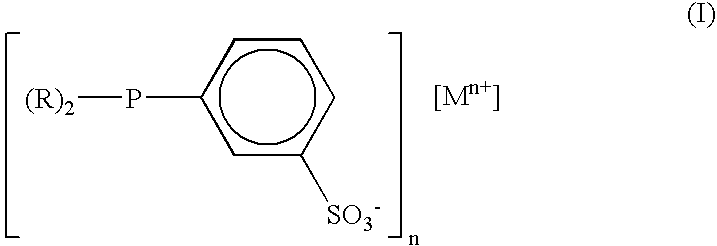Aldehyde and alcohol compositions derived from seed oils
a technology applied in the field of aldehyde and alcohol compositions, can solve the problems of inacceptable rigidity or flexibility of foam
- Summary
- Abstract
- Description
- Claims
- Application Information
AI Technical Summary
Benefits of technology
Problems solved by technology
Method used
Image
Examples
example 1
[0055] A catalyst solution was prepared by dissolving dicarbonylacetylacetonato rhodium (I) (0.078 g) and dicyclohexyl-(3-sulfonoylphenyl)phosphine mono-sodium salt (0.7513 g) in n-methyl-2-pyrrolidinone (NWP) (53.8934 g) under a nitrogen atmosphere. A portion of the resulting mixture (11.06 g) was then transferred to a nitrogen-purged 100 mL stainless steel autoclave and heated to 90° C. under 200 psig (1,379 kPa) of synthesis gas (1:1 hydrogen:carbon monoxide) with mixing via mechanical agitation at 700 rpm. The mixture was heated for about 15 minutes. To this mixture was added under synthesis gas soy methyl esters (38.98 g) comprising by weight 9 percent methyl palmitate, 5 percent methyl stearate, 24 percent methyl oleate, 51 percent methyl linoleate, and 8 percent methyl linolenate. The reactor pressure was maintained at 400 psig (2,758 kPa) by the addition of fresh synthesis gas. The mixture was analyzed after 22.5 hours of reaction time. The resulting unsaturated ester conver...
example 2
[0056] The procedure described in Example 1 was repeated with the following modifications: catalyst solution (10.92 g) and soy methyl esters (39.19 g). Temperature was maintained at 90° C. and pressure at 400 psig (2,758 kPa). After 20 hours of reaction time an aldehyde composition obtained from the reaction mixture was analyzed with the results shown in Table 1.
example 3
[0057] A catalyst solution was prepared by dissolving dicarbonylacetylacetonato rhodium (I) (0.080 g) and dicyclohexyl-(3-sulfonoylphenyl)phosphine mono-sodium salt (0.3514 g) in n-methyl-2-pyrrolidinone (NMP) (54.059 g) under a nitrogen atmosphere. A portion of the resulting mixture (11.17 g) was then transferred to a nitrogen-purged 100 mL stainless steel autoclave and heated to 90° C. under 200 psig (1,379 kPa) of synthesis gas (1:1 hydrogen:carbon monoxide) with mixing via mechanical agitation at 700 rpm. The mixture was heated for about 15 minutes. To this mixture was added under synthesis gas soy methyl esters (39.09 g) comprising by weight 9 percent methyl palmitate, 5 percent methyl stearate, 24 percent methyl oleate, 51 percent methyl linoleate, and 8 percent methyl linolenate. The reactor pressure was maintained at 400 psig (2,758 kPa) by the addition of fresh synthesis gas. The mixture was analyzed after 25.5 hours of reaction time. The resulting unsaturated ester convers...
PUM
| Property | Measurement | Unit |
|---|---|---|
| Temperature | aaaaa | aaaaa |
| Temperature | aaaaa | aaaaa |
| Temperature | aaaaa | aaaaa |
Abstract
Description
Claims
Application Information
 Login to View More
Login to View More - R&D Engineer
- R&D Manager
- IP Professional
- Industry Leading Data Capabilities
- Powerful AI technology
- Patent DNA Extraction
Browse by: Latest US Patents, China's latest patents, Technical Efficacy Thesaurus, Application Domain, Technology Topic, Popular Technical Reports.
© 2024 PatSnap. All rights reserved.Legal|Privacy policy|Modern Slavery Act Transparency Statement|Sitemap|About US| Contact US: [email protected]










